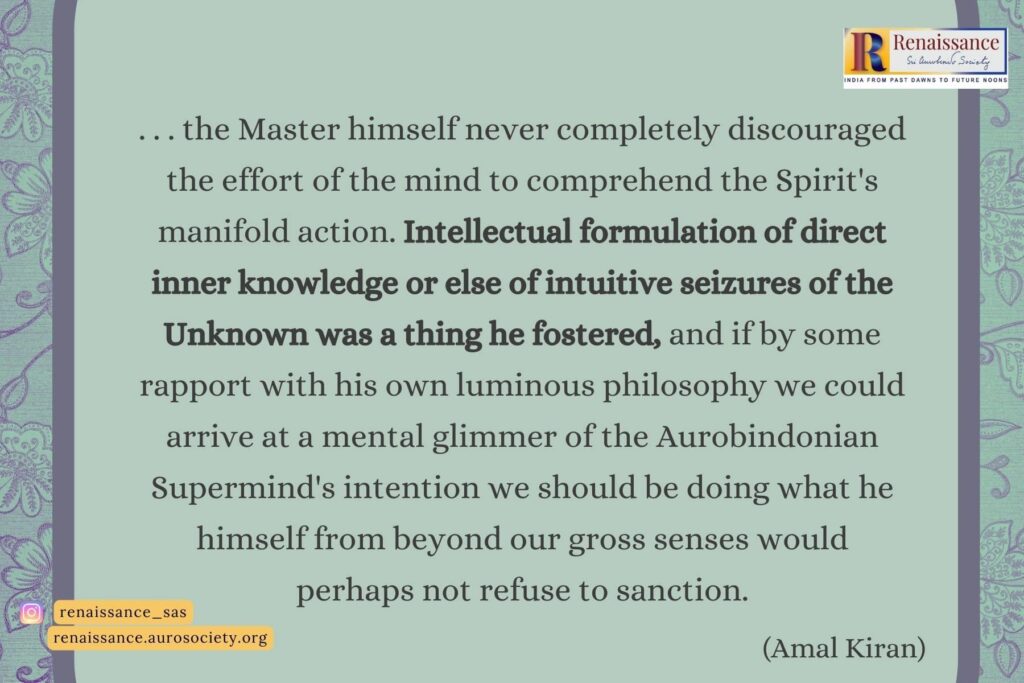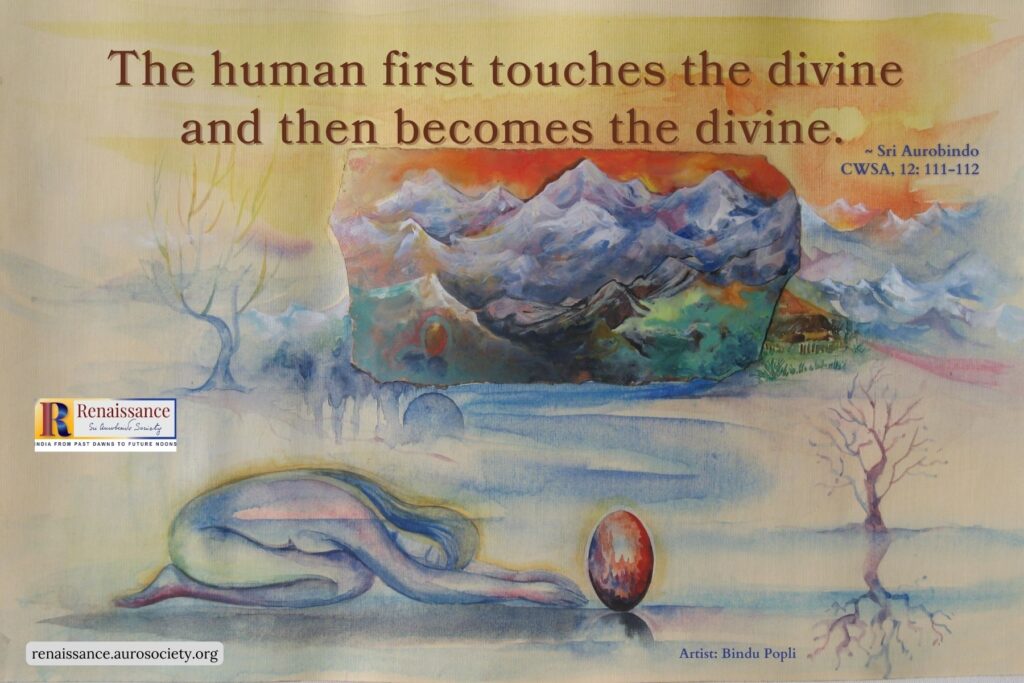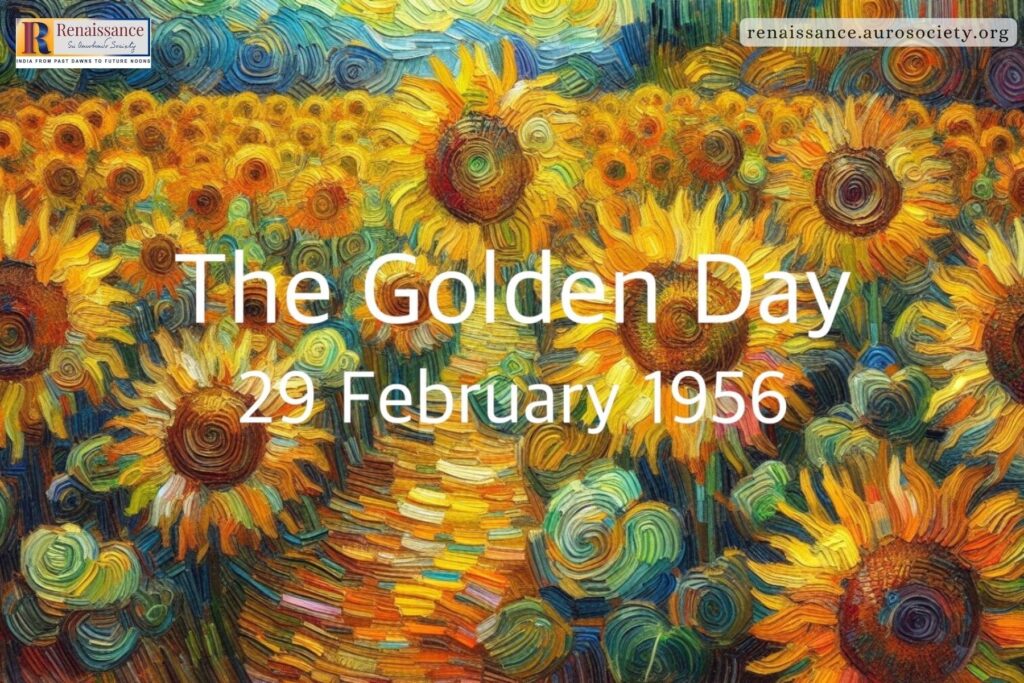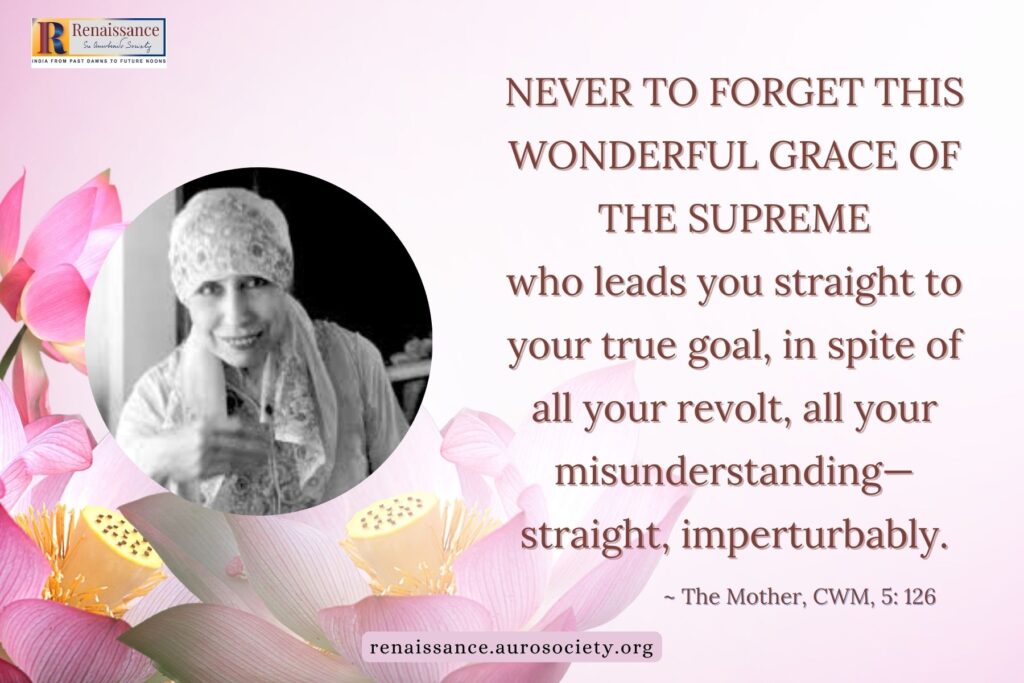Continued from Part 1

PART 2
When during the transition to life’s close and even after, in the very thick of death, a challenging lordship is manifested over Matter and the transformative power of the Supermind that was ever increasingly Sri Aurobindo’s is not denied but paradoxically proved, it is—to say the least—reasonable to see the whole event of his passing as the culmination of a momentous deliberate fight whose implications can be read only by understanding a little of what the supramental light means.
But here the question arises: If the fight was deliberate, did he give any signs of its coming?
The answer is: Yes.
It is indeed true that, though the great illuminating letters to his disciples had not quite ceased nor had the fine humour forgotten altogether its leap and flash nor yet the wide look on the world’s movement turned away, he had been for the last couple of years rather reticent about his plans for the future and more and more absorbed in his own inner spiritual work and in literary creation, especially his epic poem Savitri: A Legend and a Symbol.
But through the reticence and the absorption a few hints did glimmer out of a strange and dire possibility he might have to confront in the course of his mission.
A Few Hints
Some time in November the predictions of a Gujarati astrologer were read out to him. Their focal points were the years 1950 and 1964. The astrologer wrote:
“In 1950, as the sun and the moon are in conjunction and the moon is the master of the twelfth house, there is a chance of Sri Aurobindo’s self-undoing.”
About 1964 he opined:
“In that year some mighty miracle of Sri Aurobindo’s power will be witnessed. Aged 93, he will withdraw from the world at his own will after completing his mission.”
On hearing this, Sri Aurobindo raised his hand and half-jocularly said: “Oh, ninety-three!” as if he had found that age too far away for his mission’s achievement. With regard to 1950 a disciple remarked that it must be a year of importance, since important things had happened in Sri Aurobindo’s life at intervals of 12 years.
- 1914 made a most meaningful new starting-point for him in creative spirituality: he first met the Mother and the ostensible result of their meeting was the publication of the philosophical monthly, Arya, which ran for nearly 7 years thereafter.
- 1926 was another outstanding landmark in Sri Aurobindo’s spiritual career: it is called the year of assurance of victory and marks practically the beginning of the Ashram with the Mother radiantly presiding over it.
- In 1938—12 years after that landmark—Sri Aurobindo passed through a physical crisis by falling and fracturing his right thighbone.
- 1950—with its indication of a possibility of “self-undoing”—makes again a 12 years’ lapse.
And, though the astrologer took only his forecast of a memorable ninety-third year in Sri Aurobindo’s life very seriously, Sri Aurobindo seemed to regard his statements as not quite fantastic. He said: “The man has got hold of some truth.”
Then he was asked: “Isn’t the prediction about your ‘self-undoing’ this year nonsensical? Surely, you are going to stay with us?” In his grand unhurrying way came the calm counter-query of just one mysterious word: “Why?” A most surprising word, this, to all who had expected that an unusual longevity as a result of the Supermind’s increasing descent was part of Sri Aurobindo’s programme.
Sudden Personal Tenderness
Another surprise was fraught with a strange foreboding joy. To those who looked after him or worked in his room he gave a sign of sudden personal tenderness.

Sri Aurobindo was not exactly a demonstrative nature: he had the subtle kindness as of an all-enveloping ether and though his extreme compassion is evident both in the labour he undertook and in the many letters written to his disciples in difficulty, physical expressions of his great paternal attitude were rare. But now for a brief moment there went out to his attendants—to each in a different way and on a different occasion—a distinct outward gesture of affection, as if he had wished them to know before it might be too late his appreciation of their service. The gesture, exceedingly sweet and welcome though it was, appeared to hold vaguely in it the poignancy of a possible leave-taking.
“Must finish Savitri soon”
A third surprise may be recorded: a remark which fell oddly on the ear of the disciple whose job it was to take down whatever Sri Aurobindo dictated by way of letter or book.
The Master had been busy with his Savitri for several years, revising the text he had composed earlier and constantly adding to it, amplifying the significances, enriching the story, extending the symbolism, catching more and more intensely the vision of the superhuman planes of existence and consciousness to which he had access, breathing with an ever-truer thrill the vast rhythms of the movements of the Gods with which he had grown familiar.
Out of some unfathomable silence he would draw out golden phrase and apocalyptic line—wait as if he had eternities to throw away—proceed with splendid bursts of occult imagery and revealing description—hark back to expand or amend, with an eye to the tiniest detail of punctuation or sequence, and again press forward with a comprehensive yet meticulous inspiration.
A lordly, a leisurely labour was Savitri, conceived with something of the antique temperament which rejoiced in massive structure—especially the temperament of the makers of the Ramayana and the Mahabharata which take all human life and human thought in their spacious scope and blend the workings of the hidden worlds of Gods and Titans and Demons with the activities of earth.
A kind of cosmic sweep was Sri Aurobindo’s and he wanted his poem to be a many-sided multi-coloured carving out, in word-music, of the gigantic secrets of the supramental Yoga. At least twenty-four thousand lines were thought necessary to house the unique vision and the unparalleled experience. A patience as vast as that vision and that experience characterised always Sri Aurobindo’s dealings with this epic. Even the version on which he was engaged was the eleventh or the twelfth.

Time without end appeared to be at his disposal when he sat dictating lines like those about the central figure of the poem:
As in a mystic and dynamic dance
~ Savitri, CWSA, Vol. 33, p. 15
A priestess of immaculate ecstasies
Inspired and ruled from Truth’s revealing vault
Moves in some prophet cavern of the Gods,
A heart of silence in the hands of joy
Inhabited with rich creative beats
A body like a parable of dawn
That seemed a niche for veiled divinity
Or golden temple door to things beyond.
But all of a sudden a couple of months before the fateful December 5 Sri Aurobindo startled his scribe by saying: “I must finish Savitri soon.”
Grappling the Grim Spectre in Actuality
Of course, all this does not fix the very date of his passing nor does it show any desire to depart, but, clearly, the grim struggle in which he got involved and which came to a close on that date had loomed already as a likelihood in the near future. And a certain fact about Savitri fits in here with the aptest symbolism.
Though he strove to finish his epic soon, it just fell short of completion. It had been projected in twelve Books, with an epilogue, but while even the epilogue got written—at least as a general first draft—and the Book of Beginnings, the Book of the Traveller of the Worlds, the Book of the Divine Mother, the Book of Birth and Quest, the Book of Life, the Book of Love, the Book of Fate and several other Books are available for enthusiasts of spiritual poetry, the one single Book which does not exist in any form at all—except for a short piece written a long time ago and meant to be revised and included in a much larger whole—is the Book of Death.
Most suggestive is this fact, as if that Book could not be composed until the Grim Spectre had been grappled with in actuality and as if Sri Aurobindo had been waiting for some mighty crisis of his own bodily existence before he could launch on this part of his Legend and Symbol.
Everything goes to prove that what happened in the small hours of that December day was no purely physical casuality, no fell accident to the seeker of the life divine on earth, but a dreadful gamble freely accepted, an awesome trial undergone for a set purpose, a battle faced in every wounding detail with open eyes and joined with the explicit possibility threatening him of losing in it the most gifted and glorious bodily instrument forged by the manifesting Spirit that is for ever.
Why the Perilous Experiment?
But the question still stands to be answered: What could be the reason of the perilous experiment?

It is doubtful whether any answer expressible by the mere mind can be entirely satisfying. Perhaps none ought to be attempted and we might rest, with the conviction that Sri Aurobindo of his own will did what he deemed most necessary for the advancement of his work and we might leave it to the Mother—Sri Aurobindo’s partner in that work—to unroll the supreme rationale of the Master’s will in the actual developments of the Integral Yoga in the future.
However, the Master himself never completely discouraged the effort of the mind to comprehend the Spirit’s manifold action. Intellectual formulation of direct inner knowledge or else of intuitive seizures of the Unknown was a thing he fostered, and if by some rapport with his own luminous philosophy we could arrive at a mental glimmer of the Aurobindonian Supermind’s intention we should be doing what he himself from beyond our gross senses would perhaps not refuse to sanction.

Continued in Part 3
Read PART 1
~ Graphic design: Beloo Mehra & Biswajita Mohapatra



